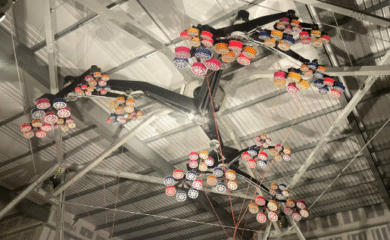What is a worm gear?
A worm gear is a type of staggered shaft gear that transmits motion between two shafts that are neither intersecting nor parallel. Even though it is compact it can provide a large speed reduction. A worm gear is a thread cut into a round bar, and a worm wheel is a gear that meshes with the worm at a shaft angle of 90 degrees. The set of a worm and worm wheel is called a worm gear. Its history is so old that its existence is described by Archimedes in around 250 BC.
There are roughly two types of worm gears:
One is a cylindrical worm that meshes with a worm wheel as a pair to form the “cylindrical worm gear”. The other is the “drum-shaped worm gear” which is a pair consisting of a drum-shaped worm and a worm wheel. The latter type is also called “throated worm gear”.
When a worm gear is used, a compact and high speed reduction ratio can be obtained as compared with spur gears. The reduction ratio is determined by the combination of the number of worm threads and the number of teeth on the worm wheel. For example, in the case of the worm gears of the KHK’s standard gears, a reduction ratio of up to the maximum of 1/120 can be obtained.
Worm gears have advantages such as low noise and low vibration, but because power transmission is effected by sliding contact, it also has the disadvantage of retaining heat and its transmission efficiency is not high (in the case of a cylindrical worm gear, the general efficiency is about 30 – 60%).
To reduce wear, worms are generally made of a harder material than worm wheels. For KHK standard gears, mechanical structural carbon steel (S45C), mechanical structural alloy steel (SCM440), stainless steel, etc. are used for worms, while cast iron (FC200), phosphor bronze and aluminium bronze, and MC nylon (an engineering plastic) are used for the worm wheel.
The lead of the left and right tooth surfaces of the worm is normally equal, however there is also another type called dual-lead worm gear which is made with a different lead for the two surfaces. When using the latter type worm gear, it is possible to move the worm axially by a shim which allows the adjustment of backlash. In cases, such as when tooth wear produces the need for readjustment of the backlash, it can be accomplished without changing the centre distance between worm and worm gear.
When using a worm gear, the worm is the driver and the worm wheel is the driven shaft. When the worm’s lead angle is especially small, it becomes impossible to turn the worm by the worm wheel. This condition is called self-locking, and the result of preventing the reverse motion is expected. However, since it is not a totally dependable function, it is desirable to use it in combination with another method when a total prevention of reversal is required.
Examples of worm gear applications include speed reducers, elevators, machine tools, chain blocks, fishing reels and automotive power steering.
Small module worm gears
For high-tech applications such as robotics and medical equipment, small worm gears such as module 0.5 and module 0.8 are ideal.




